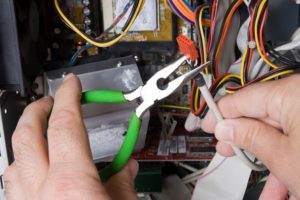The purchase of an older fixer-upper house is often a happy occasion for the buyers because the structure is one they can remodel and customize to their hearts’ content, without spending too much money on the actual purchase price. However, older homes often bring with them a basic problem: old wiring.
While the fact that the actual wires are old isn’t always bad, age can affect how well wiring works. However, if the wiring materials were of good quality, then age alone may not have an effect, and the electricity in the house could run just fine.
However, if the house still uses fuse boxes, or if the fuses were replaced with circuit breakers several decades ago, the amount of power available to the home may be too low because that wiring was installed with the power draws of those years in mind. In that sense, old wiring can be a real pain to use.
If you have bought an old house and want to upgrade, then you should definitely upgrade the wiring, from fuses to circuit breakers, and from older breakers to newer ones. However, do not attempt this yourself, and don’t assume that all you need to do is replace the physical breakers. You have to increase the amount of power available to the house, which you may need a professional’s advice on.
The Problem With 15-Amp Circuits
Most older homes have been upgraded to have at least 15-amp circuits. In the 1970s, when many of these upgrades were made, 15 amps was more than enough energy. Laundry equipment, electric heaters and air conditioners, and other large appliances would have been on their own circuits, which could have been as large as 20 amps.
However, for bedrooms, living rooms, and even bathrooms, 15 amps was enough. Appliances like lamps and even old hair dryers just didn’t draw a lot of power.
Nowadays, the appliances you might use in each room are much more powerful. Hair dryers can draw close to 15 amps now, which means that plugging in a hair dryer, turning on the light, and turning on the exhaust fan in a bathroom on a 15-amp circuit could easily overload and trip the circuit.
If you’re not careful, then even vacuums, mini-fridges, and other electrical equipment like space heaters can overload 15 amps. When you upgrade, those 15-amp circuits should be replaced with 20-amp circuits.
What’s more complicated is that many older structures can have more than one room on a 15-amp circuit. The dining nook and living room could be on one 15-amp circuit, making TVs, lights, electric kettles in the den, and more create an overload. When you upgrade, you should separate rooms and place each on its own circuit.
The Future Is Now for New Wiring
So you’ve worked out how many circuits you would need now to successfully power all your modern gadgets, right? Now increase this number so that, as power needs increase in the future — and with all the new gadgets being invented, an increased power need is a given — your house’s power supply remains adequate.
You don’t want to rewire the house only to find that it no longer provides an adequate power supply 10 or 20 years from now.
It’s vital to note that when you upgrade, you’re not just upgrading the outlet or the breaker switch. The entire system, from the wire gauges to the outlets, needs to be able to handle the power load. Call an electrician service like A to Z Electric Co. to handle the work. You must be sure that the whole system will work together to provide power, and professionals are the ones who can rewire your entire home properly.

